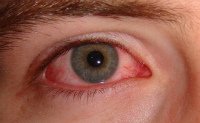|
Eye Allergies
Do you have chronic headaches from sinus congestion? How about coughing, sneezing, and runny nose? Do you experience itchy nose and throat? These symptoms may indicate that you suffer from allergies. You certainly are not alone. Fifty million Americans suffer from allergies each year with a majority of these suffering from seasonal allergies. Allergies can often involve eye allergies. How do I know if I have eye allergies?

Symptoms include itchy eyes and watery discharge along with a history of allergies. The conjunctiva is the clear tissue covering the white part of the eye (the sclera) and lining the inside portion of the upper and lower lids. This tissue is rich in blood supply and as such has abundant immune mediators. Add to this the fact that this tissue is in direct exposure to the environment, it is not surprising that it is often involved in immune-mediated, allergic reactions. What in the environment could be affecting my eyes like this?
Allergens can be found either indoors or outdoors. Outdoor allergens include pollen and grasses. Indoor allergens include dust mites and pet dander. Other potential allergens are contact lens materials and/or contact lens solutions or the preservatives in certain eye drops. These allergy triggers can cause immune-mediated reactions in the conjunctiva and result in allergic conjunctivitis. What if I have eye allergies and wear contact lenses?
If you suffer from allergies, you should discontinue contact lens wear when your eye symptoms flare up. Common eye allergy symptoms include: If you have allergies, it is especially important for you to be diligent about cleaning and disinfecting your contact lenses. Proteins found in tears can aggregate and deposit on the contact lens surface. As you blink, these deposits rub against the sensitized conjunctiva, worsening your eye allergies symptoms. For this reason, you should purchase a separate daily cleaner to digitally rub your contact lens surface. After rubbing your lenses place them in a peroxide disinfecting solution to ensure maximum disinfection. Another option you have is to use daily disposable contact lenses, which are not susceptible to contact lens surface deposits like conventional or disposable contact lenses. How can I treat my eye allergies?
Many people buy over-the-counter (OTC) decongestants in order “to get the red out” or antihistamine eye drops for relief of itchiness. The problem with OTC decongestants and antihistamines is that they treat the symptoms without addressing the cause of the allergic reaction. For this reason, their effect is temporary. Eye decongestants are similar to nasal decongestants, and can result in dependency on these drops in order to keep the eyes white. When the person tries to stop using the drops, a rebound effect can occur where the eyes are actually redder than usual for a time. These drops are not recommended to be used in any long-term manner. A better and more conservative alternative for mild symptoms is to use a lubricating drop. These artificial tears, as they are called, can serve two purposes. First, these drops are soothing to the eye. If you put the eye drop bottle in the refrigerator, the cool drop will help itchiness and the eye dryness that often accompanies eye allergies. Secondly, using artificial tears will help dilute, or wash out, allergens out of the eye. More severe symptoms of eye allergies can include: These symptoms need comprehensive treatment, which should include: |




